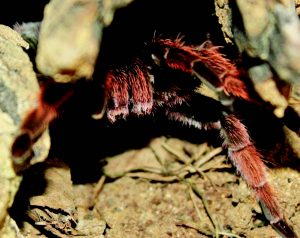The Mexican Pink Tarantula—also known as the Mexican Pink Beauty—is one of the rarest Brachypelmas and one of the 9 endangered species of tarantulas in Mexico. They thrive in the Southern Pacific coast of Mexico North and Central Americas in the humid, arid, and deciduous forest zones, mostly away from human activity and interaction.
Scientifically known as the Brachypelma klaasi, it prefers dry soil that is sandy or rich in organic matter. They are relatively easy to care for and are such an attractive spectacle in a terrarium. The Mexican Pink Tarantula can also be seen in several zoos, which is where most people learn about them. However through the years, people began to want their own; this led to the demand for them in the pet trade. People near the Mexican Pink Tarantula’s habitat now hunt them down for sale. Now, the Brachypelma klaasi is a protected species as their population in the wild continues to drop.
BEHAVIOR, TEMPERAMENT, AND LIFESPAN
The Mexican Pink Tarantula is easy to love with its color and temperament, despite being considered a “creepy crawly.” It has no recorded bites on humans to date, so the venom and sensation after envenomation is not yet known, but it is most likely similar to the venom of the other members of Brachypelma.
The Brachypelma klaasi is a very docile tarantula. They only retreat to their burrows if necessary, and in terrariums, they seldom make excessive burrows as adults, as long as they feel safe. It is docile enough to be handled.
Their primary defense is their urticating hairs, which they are able to kick from their abdomens and sprinkle on their attacker. On humans, this results in an itchy sensation followed by a mild rash, unless hypersensitivity occurs, but the urticating hairs are generally harmless, except when it gets in the eyes.
The Mexican Pink Tarantula is diurnal, which means that they are most active during the day. Most tarantulas are active at night, and this is another reason why the Mexican Pink Tarantulas are highly sought after. They make great pets and are active most of the time humans are also awake.
Often ambush predators, they wait quietly as their prey comes to them, but sometimes they will also travel far from their burrows in the neighboring vegetation, looking for food such as insects and other smaller animals. They have a huge appetite and will eat until their abdomens significantly increase in size as long as food is available.
The females of the Mexican Pink Tarantula can live up to 30 years in the wild, while the males live significantly shorter lives than females. They grow and age slowly and in the wild; only a few reach adulthood.
IN THE WILD: ECOLOGICAL IMPORTANCE
The Brachypelma klaasi has predators of its own, and this naturally controls their population, keeping the balance in the ecosystem. These include armadillos, skunks, snakes, other tarantulas, and tarantula wasps. Their defense mechanism (urticating hairs) is not always effective on all predators.
Despite their pink color, they are actually well camouflaged in their natural habitat, and are able to avoid predators with their coloration, which blends with the environment. Mexican Pink Tarantulas help control the population of insects and other small animals in their habitat, thus helping prevent overpopulation of a specific species. As spiderlings, they also create several burrows; this helps with soil aeration and improves the growth of plants.
CONSERVATION STATUS
The Mexican Pink Tarantula is listed as an endangered species in the Convention on International Trade in Endangered Species of Wild Fauna and Flora (CITES), Appendix II and is the rarest and most threatened Mexican Tarantula. The main reasons for their decreasing population are illegal hunting—it is hunted to be sold on the exotic pet black markets—and habitat degradation.
Initiatives are being undertaken to increase their wild population. The Brachypelma klaasi are now under captive breeding programs for future reintroductions to the wild. Captive breeding of these tarantulas can help bring back wild populations. Their behavior is also not altered through captive breeding.
Unlike other animals whose behavior can be altered through domestication, tarantulas cannot be truly domesticated or tamed. Tarantulas are driven by their instincts and physical needs. Similar captive breeding efforts are being done with other endangered Brachypelma species.
Females are larger than males when the Brachypelma klaasi reach adulthood. They weigh between 19.7 up to 50 grams as adults, reaching up to 6 inches in diagonal leg span. The adult males and females differ in their physical appearance. Adult males have hooks and the tips of their pedipalps bulge like gloves. These are used during mating to hold the female as the male deposits his sperm to fertilize the female’s eggs.
Their courtship and mating begins with the male tapping the ground with its pedipalps, and the female will respond with taps of her own. The male will begin to approach the female if she is receptive to the male’s intentions. If the female permits the male’s advances, they will begin mating and the male will either run for his life or get eaten by the female after mating. If the male survives, he will leave a silk bedding near the female’s burrow so it will be difficult for other males to locate her.
This appeared in Animal Scene magazine’s October 2017 issue.






